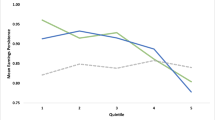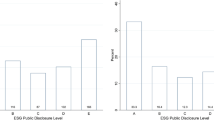Abstract
This paper constructs a theory of dividend restrictions in incomplete markets in an attempt to better understand the role of accounting constructions in optimal dividend restrictions. An entrepreneur, through his company, borrows money from a lender, and repays the debt from a stream of stochastic cash flows. Dividend restrictions are used to balance insolvency costs against the costs of accumulating surplus cash. Of particular concern is whether optimal dividend restrictions can be characterized as defining an accounting-earnings-based reservoir available for dividends, and whether earnings calculated for this purpose exhibit conservatism.
Similar content being viewed by others
References
Andenæs, T. (1985). Ársoppgjøret i praksis. Oslo: Forlag Andenæs.
Beaver, W. H., and S. G. Ryan. (1995). “Accounting Conservatism and Delayed Recognition and Their Effects on the Ability of the Book-to-Market Ratio to Predict Book Return on Equity and Security Return.” Mimeo: Stanford University/New York University.
Benish, M., and E. Press. (1993). “Costs of Technical Violation of Accounting-Based Debt Covenants.” The Accounting Review, 233-257.
Berlin, M., and J. Loeys. (1988). “Bond Covenants and Delegated Monitoring.” Journal of Finance 43(2), 397-412.
Chang, C. (1990). “The Dynamic Structure of Debt Contracts.” Journal of Economic Theory 52.
Chen, K., and K. Wei. (1993). “Creditors' Decisions to Waive Violations of Accounting-Based Debt Covenants.” The Accounting Review, 218-232.
DeAngelo, H., L. De Angelo, and D. Skinner. (1994). “Accounting Choice in Troubled Companies.” Journal of Accounting and Economics, 113-144.
DeFond, M., and J. Jiambalvo. (1994). “Debt Covenant Violation and Manipulation of Accruals.” Journal of Accounting and Economics, 145-176.
El-Gazzar, S. (1993). “Stock Market Effects of the Closeness to Debt Covenant Restrictions Resulting from Capitalization of Leases.” The Accounting Review, 258-273.
Feltham, G. A., and J. A. Ohlson. (1995). “Valuation and Clean Surplus Accounting for Operating and Financing Activities.” Contemporary Accounting Research, 689-731.
Financial Accounting Standards Board. (1980). Statements of Financial Accounting Concepts No. 2: Qualitative Characteristics of Accounting Information.
Gale, D., and M. Hellwig. (1985). “Incentive-compatible Debt Contracts: The One-Period Problem.” Review of Economic Studies 52.
Gjesdal, F. (1993). “Moral Hazard with Hidden Information.” Mimeo: Norwegian School of Economics and Business Administration.
Hart, O. (1995). “Firms, Contracts and Financial Structure.” New York: Oxford University Press.
Hart, O., and J. Moore. (1989). “Default and Renegotiation: A Dynamic Model of Debt.” Working Paper, MIT Department of Economics, 520.
Hart, O., and J. Moore. (1994). “A Theory of Debt Based on the Inalienability of Human Capital.” Quarterly Journal of Economics, 841-879.
Hart, O., and J. Moore. (1995). “Debt and Seniority: An Analysis of the Role of Hard Claims in Constraining Management.” American Economic Review, 567-585.
Hendrickson, E., and M. van Breda. (1991). Accounting Theory. 5th ed. Homewood: Irwin.
Jensen, M. (1986). “Agency Costs of Free Cash Flow, Corporate Finance, and Takeovers.” American Economic Review, 323-329.
John, K., and A. Kalay. (1982). “Costly Contracting and Optimal Payout Constraints.” Journal of Finance 37, 457-470.
Kalay, A. (1982). “Stockholder-Bondholder Conflict and Dividend Constraints.” Journal of Financial Economics 10:2, 211-233.
Leite T. (1998). “Multiperiod Debt Contracts under Costly State Verification.” In “Essays in Corporate Finance.” Doctoral dissertation, Norwegian School of Economics and Business Administration.
Leuz, C., D. Deller, and M. Stubenrath. (1998). “An International Comparison of Accounting-Based Payout Restrictions in the United States, United Kingdom and Germany.” Accounting and Business Research 28(2), 111-129.
Leuz, C. (1996). “The Role of Accounting in Restricting Dividends to Shareholders.” Mimeo, Johann Wolfgang Goethe-Universität, Frankfurt am Main.
Littleton, A. C. (1934). “Dividends Presuppose Profits.” The Accounting Review 9:4, 304-311.
McConnell, J., and G. Schlarbaum. (1981). “Return, Risks, and Pricing of Income Bonds, 1956-78 (Does Money Have an Odor?).” Journal of Business 1.
Mohrman, M. (1993). “Debt Contracts and FAS No. 19: A Test of the Debt Covenant Hypothesis.” The Accounting Review, 273-288.
Paton, W., and A. Littleton. (1940). An Introduction to Corporate Accounting Standards. American Accounting Association Monograph No. 3.
Scott, J. (1977). “A Theory of Optimal Capital Structure.” Bell Journal of Economics.
Smith, C. (1993). “A Perspective of Accounting-Based Debt Covenant Violations.” The Accounting Review, 289-303.
Smith, C., and J. Warner. (1979). “On Financial Contracting: An Analysis of Bond Covenants.” Journal of Financial Economics 7:2, 117-162.
Smith, C., and R. Watts. (1992). “The Investment Opportunity Set and Corporate Financing, Dividend, and Compensation Policies.” Journal of Financial Economics, 263-292.
Sweeney, A. (1994). “Debt-covenant Violations and Managers Accounting Responses.” Journal of Accounting and Economics, 281-308.
Townsend, R. M. (1979). “Optimal Contracts and Competitive Markets with Costly Verification.” Journal of Economic Theory 22.
Watts, R., and J. Zimmerman. (1986). Positive Accounting Theory, Englewood Cliffs: Prentice-Hall.
Williamson, O. (1988). “Corporate Finance and Corporate Governance.” Journal of Finance 43:3, 567-591.
Author information
Authors and Affiliations
Rights and permissions
About this article
Cite this article
Gjesdal, F., Antle, R. Dividend Covenants and Income Measurement. Review of Accounting Studies 6, 53–76 (2001). https://doi.org/10.1023/A:1011334120714
Issue Date:
DOI: https://doi.org/10.1023/A:1011334120714




